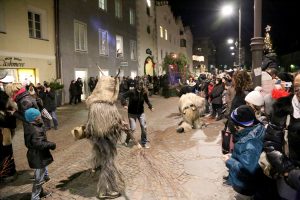That of presepe is, very likely, Italy’s best known Christmas tradition: it is popular from north to south and it is indissolubly tied to one of the country’s most important religious figures, Saint Francis of Assisi, patron on the nation.
More prosaic in its nature – and, in truth, acquired from German traditions – but almost as loved is the ubiquitous Mercatino di Natale: every town, village and city has one nowadays.
When it comes to Christmas traditions, though, Italy is much more than this, and it could not be any different, considering how varied the country is in its culture and heritage. In each region, in each town even, Christmas turns into a mirror to antique gestures, tales and habits, rooted in a past made of history and, sometimes, pagan mystery.
Such is the case, for instance, of the “fire celebrations” (Confuoco in Italian and o Confeugo in dialect) popular throughout Liguria, that take place usually on Christmas Eve. Very likely born to honor Genoa’s Podestà (the city’s highest political figure at the time) in the 14th century, it became soon popular throughout the region, where it is still widely celebrated today: during the feast, a large laurel tree trunk is adorned with olive trees’ branches and set on fire, in a symbolic act representing the end of the year’s problems, burned and turned, quite literally, into ashes.
The association of Christmas with fire is present in other areas of Italy, too: in Abbadia San Salvatore, near Siena, large wood piles are prepared on the day of the Immaculate Conception, on the 8th of December, and set on fire, again, on Christmas Eve. The ritual of Abbadia San Salvatore probably has pagan origins, and it may have been associated to the cleansing power of fire. In Palena, Abruzzo, thirteen small pieces of wood are ritually burned in memory of Christ and his Apostles in the days leading to the 25th.
The presence of fire during Christmas celebrations is common also in Sardinia, where it is associated to the pastoral tradition of the region. On the 26th of December, day of Saint Stephen, patron protector of both sheep and hunting dogs, owners burn the tiniest amount of fur on their four-legged friends’ head, to form a cross meant to protect them from evil and danger. Always in Sardinia, especially in the Sassari province, it is customary to make a crown-shaped bread, symbol of rural life and work, which a father places on the head of his first born on New Year’s Eve. The gesture was traditionally believed to protect the family and to bring abundance and wealth upon the newer generations.
Forget about fire and think about saints once more, while we move to Trentino Alto Adige. The region repletes with Germanic influences and habits, so it comes as no surprise to know worship of Saint Nicholas and celebrations of his feast are extremely popular.

As many may know, Saint Nicholas, celebrated on the 6th of December, is the original Winter season’s gift bearer, this connotation inherited directly from his very own hagiography, where wide mention is made of how he would regularly visit the poor of his diocese, bringing food, clothes and other essentials to those struggling the most. In Trentino, but especially in the German-speaking area of Alto Adige, Saint Nicholas’ celebrations extend to the 7th of December, when a ghastly parade, that of the demonic Krampus, takes places: in it, a large number of animal-like people runs in the streets, followed by Saint Nicholas, who protects onlookers from their violence.
Legends say that, originally, Krampus were nothing more than a gang of kids who used to hang around the city of Myra (home to Saint Nicholas) scaring people. Taking advantage of how mischievous they were, the devil insinuated himself among them. Terrified by the event, the rascals asked for Saint Nicholas’ help and were freed from the evil presence thanks to his actions. It is, indeed, this occurrence that the Krampus parade celebrates each year.
One last, curious Christmas time tradition is that of Grado, elegant thermal town in the province of Gorizia. Every year, on the 6th of January, day of the Epiphany, Grado receives the visit of the varvuole. These frightful creatures are witches coming from the sea on glass ships, seeking all kids who misbehaved during the year to punish them. The old legend is revisited today in a less unsettling manner, with the varvuole coming to Grado only to joyfully party in its streets and alleys.
Pagan fires, saints, witches and Podestà: Christmas traditions in Italy are also all of this. However, if you really cannot live without a presepe, then head to the Umbrian town of Greccio where, in 1223, Saint Francis of Assisi created the first one, to experience a bit of that magic mix of history, tradition, spirituality and legends Italian Christmases are made of.































